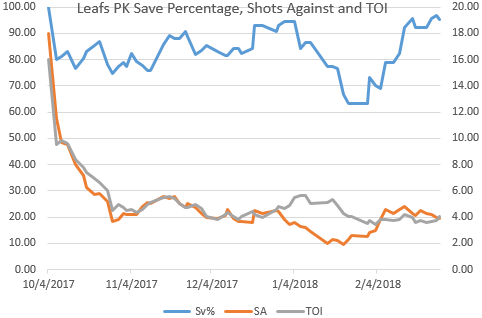Sometimes, the greatest thing that comes out of analyzing the game is what you learn about yourself.
I’ve begun to really appreciate the element of speedy forwards on the penalty kill. The Leafs have an aggressive approach in the defensive zone, but a failed zone entry, or effective forechecking through the neutral zone, makes the transition dangerous.
Deterring the power play unit from setting up in formation is the foundation to defensive zone coverage and puck retrieval. Without the formation setup and set plays, the power play resorts to improvisation and forcing more individually. Breaking the system is the key to being a good penalty-killing unit.
Penalty killing units should be seamless and interchangeable as far as player personnel, without sacrificing success or consistency. Special teams are system-driven and players could be dropped onto the PK unit, be it situational or due to injury to regular penalty killers.
The addition of Kasperi Kapanen as a regular has augmented the Leafs’ PK. Kapanen takes advantage of his first two-step acceleration and high-octane speed to add a threat in transition, similar to the effect of speedster Michael Grabner in New York (and now New Jersey).
There’s been a recent groundswell of support for using star players in shorthanded situations – you clearly want to use skill in every situation in the modern game – to exploit offensive opportunities and transition. The concept of possession, even when down a player, is an effective way to kill off shorthanded time.
On the surface, the Leafs penalty killing is kind of… average. They’ve played 316 minutes at 4v5, a little less than the league average. They’ve scored four goals at 4v5, slightly under the 4.8 league average by a fraction. Power play goals against in three consecutive games – a first for the Leafs since early November – has dropped them down to 10th in the NHL in overall PK efficiency at 82.4%. However, prior to the recent dip, they were rolling along in the top 3-5 in the league, with less than 1% currently separating third from 10th in the PK rankings. They also have allowed only 31 goals against at 4v5, which is tied with Boston for the second least in the NHL behind only San Jose (26).
Your best penalty killer is the goaltender, and Frederik Andersen has been exceptional at 4v5. Continuing from the run beginning in November, until a tough stretch in January where the save percentage plunged (with fewer shots faced), he’s been exceptional.
| Player | GP | TOI | SA | GA | Sv% | xSv% | dSv% | LDSv% | MDSv% | HDSv% |
|---|---|---|---|---|---|---|---|---|---|---|
| GIBSON | 50 | 273.97 | 267 | 22 | 91.76 | 87.2 | 4.56 | 96.88 | 93.24 | 87.36 |
| HELLEBUYCK | 55 | 281.33 | 304 | 26 | 91.45 | 87.42 | 4.03 | 95.35 | 95.81 | 81.91 |
| VARLAMOV | 41 | 229.55 | 193 | 17 | 91.19 | 88.66 | 2.53 | 96.97 | 95.33 | 79.25 |
| ANDERSEN | 56 | 254.75 | 227 | 24 | 89.43 | 85.54 | 3.89 | 90.48 | 94.78 | 82.42 |
| VASILEVSKIY | 56 | 272.07 | 255 | 28 | 89.02 | 89.54 | -0.52 | 93.88 | 92.86 | 77.27 |

Andersen sports the NHL’s fourth-best shorthanded save percentage at 4v5 and the third best dSv% (the difference between actual and expected or xSv%). From high-danger scoring areas, he’s also been rock solid — fourth overall with a .824.
Shortly after Andersen caught fire, at the team level — until a recent down stretch — the Leafs penalty kill has outperformed the expected goals against.

The Systems
The Leafs tend to break formation and freestyle often into an organized chaos when in the defensive zone. This doesn’t seem like a tactic by design, but it seems to fuel the aggressive nature among the forwards as they track and hound puck carriers in order to get it out of the zone and force zone entries.
The disarray adds credence to the “structure, not systems” theory. The Leafs also leverage the stellar goaltending into puck retrieval.
Most teams play the same strategies with tweaks: A 2-1-2 offensive zone forecheck, a 1-2-2 in the neutral zone, and an overload in the defensive zone. Mike Babcock often acknowledges skilled players as the secret to success, and he’s right: Skill and creativity is paramount – when given the breathing room to freestyle within the system structure with proper support. Flexibility in the structure allows them to be aggressive at the top of the zone, while collapsing low to protect the house when forced.
The Leafs penalty kill seems to interchange between a wedge+1 and a hybrid box depending on how the opposition lines up. They ensure the slot area has coverage, essentially covering off the bumper in the 1-3-1.
They’re also aggressive in the neutral zone, sending the F1 deep to challenge the trailer, although they can fall back to the blue line a little too quickly at times.
On a side note: How far away are we from the widespread adoption of players skating behind the lead puck carrier to take away the drop pass at 5v4 as a zone entry strategy? Anticipating the pass to the trailer and causing a turnover, even if it doesn’t lead to a scoring opportunity, provides value in killing time off the penalty in a less dangerous area of the ice.
Failed zone entries can quickly turn into transition and create shorthanded chances against. Speedsters and puck hounds — the likes of Kapanen, Zach Hyman, Leo Komarov and Connor Brown — are offensive threats courtesy of their speed and/or aggression in getting the puck back. Forwards take the puck to the net instead of just aimlessly dumping it to kill time. I like that approach of maintaining possession by forcing the power play unit to play defense.
Kapanen has provided a dangerous element on the penalty kill, blasting off with quick acceleration and top speed to create scoring chances while shorthanded. On turnovers at the Leafs line – or pucks that slip by past the blueline and out of the zone — the Leafs can strike very forcefully, killing time off the penalty and even generating scoring opportunities.
My one little criticism is the space given up between the goaltender and the first wave of defensemen — usually a stick length away. This isn’t restricted to Toronto, either, as defensemen sometimes give up that space in order to have more zone coverage. With good first two-step acceleration, defenders can make up space quick.
Excelling via systems and structure — controlling the blue line on zone entries and forcing transition instead of just aimlessly throwing it away — will bring the Leafs further success this season. And of course, the most important component for sustaining success on the Leafs’ penalty kill is the continued health and superb play of Frederik Andersen.

































